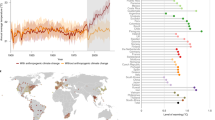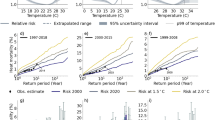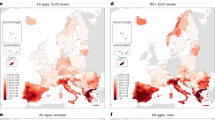Abstract
Climate change can increase the risk of conditions that exceed human thermoregulatory capacity1,2,3,4,5,6. Although numerous studies report increased mortality associated with extreme heat events1,2,3,4,5,6,7, quantifying the global risk of heat-related mortality remains challenging due to a lack of comparable data on heat-related deaths2,3,4,5. Here we conducted a global analysis of documented lethal heat events to identify the climatic conditions associated with human death and then quantified the current and projected occurrence of such deadly climatic conditions worldwide. We reviewed papers published between 1980 and 2014, and found 783 cases of excess human mortality associated with heat from 164 cities in 36 countries. Based on the climatic conditions of those lethal heat events, we identified a global threshold beyond which daily mean surface air temperature and relative humidity become deadly. Around 30% of the world’s population is currently exposed to climatic conditions exceeding this deadly threshold for at least 20 days a year. By 2100, this percentage is projected to increase to ∼48% under a scenario with drastic reductions of greenhouse gas emissions and ∼74% under a scenario of growing emissions. An increasing threat to human life from excess heat now seems almost inevitable, but will be greatly aggravated if greenhouse gases are not considerably reduced.
This is a preview of subscription content, access via your institution
Access options
Access Nature and 54 other Nature Portfolio journals
Get Nature+, our best-value online-access subscription
$29.99 / 30 days
cancel any time
Subscribe to this journal
Receive 12 print issues and online access
$209.00 per year
only $17.42 per issue
Buy this article
- Purchase on Springer Link
- Instant access to full article PDF
Prices may be subject to local taxes which are calculated during checkout





Similar content being viewed by others
References
Patz, J. A., Campbell-Lendrum, D., Holloway, T. & Foley, J. A. Impact of regional climate change on human health. Nature 438, 310–317 (2005).
Basu, R. & Samet, J. M. Relation between elevated ambient temperature and mortality: a review of the epidemiologic evidence. Epidemiol. Rev. 24, 190–202 (2002).
Kovats, R. S. & Hajat, S. Heat stress and public health: a critical review. Annu. Rev. Publ. Health 29, 41–55 (2008).
Leon, L. R. Pathophysiology of Heat Stroke Vol. 7 (Colloquium Series on Integrated Systems Physiology: From Molecule to Function to Disease, Morgan Claypool Life Sciences, 2015).
Ostro, B. D., Roth, L. A., Green, R. S. & Basu, R. Estimating the mortality effect of the July 2006 California heat wave. Environ. Res. 109, 614–619 (2009).
Glaser, J. et al. Climate change and the emergent epidemic of CKD from heat stress in rural communities: the case for heat stress nephropathy. Clin. J. Am. Soc. Nephrol. 11, 1472–1483 (2016).
Robine, J.-M. et al. Death toll exceeded 70,000 in Europe during the summer of 2003. C. R. Biol. 331, 171–178 (2008).
Sillmann, J. & Roeckner, E. Indices for extreme events in projections of anthropogenic climate change. Climatic Change 86, 83–104 (2008).
Meehl, G. A. & Tebaldi, C. More intense, more frequent, and longer lasting heat waves in the 21st century. Science 305, 994–997 (2004).
Orlowsky, B. & Seneviratne, S. Global changes in extreme events: regional and seasonal dimension. Climatic Change 110, 669–696 (2012).
Tebaldi, C., Hayhoe, K., Arblaster, J. M. & Meehl, G. A. Going to the extremes. Climatic Change 79, 185–211 (2006).
Tebaldi, C. & Wehner, M. F. Benefits of mitigation for future heat extremes under RCP4.5 compared to RCP8.5. Climatic Change http://dx.doi.org/10.1007/s10584-016-1605-5 (2016).
Sterl, A. et al. When can we expect extremely high surface temperatures? Geophys. Res. Lett. 35, L14703 (2008).
Huang, C. et al. Projecting future heat-related mortality under climate change scenarios: a systematic review. Environ. Health Persp. 119, 1681–1690 (2011).
Guo, Y. et al. Global variation in the effects of ambient temperature on mortality: a systematic evaluation. J. Epidemiol. 25, 781–789 (2014).
Luber, G. & McGeehin, M. Climate change and extreme heat events. Am. J. Prev. Med. 35, 429–435 (2008).
Bouchama, A. & Knochel, J. P. Heat stroke. New. Engl. J. Med. 346, 1978–1988 (2002).
Bobb, J. F., Peng, R. D., Bell, M. L. & Dominici, F. Heat-related mortality and adaptation to heat in the United States. Environ. Health Persp. 122, 811–816 (2014).
Gasparrini, A. et al. Temporal variation in heat–mortality associations: a multicountry study. Environ. Health Persp. 123, 1200–1207 (2015).
Lowe, D., Ebi, K. L. & Forsberg, B. Heatwave early warning systems and adaptation advice to reduce human health consequences of heatwaves. Int. J. Environ. Res. Public Health 8, 4623–4648 (2011).
Hanna, E. G. & Tait, P. W. Limitations to thermoregulation and acclimatization challenge human adaptation to global warming. Int. J. Environ. Res. Publ. Health. 12, 8034–8074 (2015).
Sherwood, S. C. & Huber, M. An adaptability limit to climate change due to heat stress. Proc. Natl Acad. Sci. USA 107, 9552–9555 (2010).
Whitman, S. et al. Mortality in Chicago attributed to the July 1995 heat wave. Am. J. Public Health 87, 1515–1518 (1997).
Dousset, B. et al. Satellite monitoring of summer heat waves in the Paris metropolitan area. Int. J. Climatol. 31, 313–323 (2011).
Shaposhnikov, D. et al. Mortality related to air pollution with the Moscow heat wave and wildfire of 2010. Epidemiology 25, 359–364 (2014).
Barnett, A. G., Tong, S. & Clements, A. What measure of temperature is the best predictor of mortality? Environ. Res. 110, 604–611 (2010).
Willett, K. M. & Sherwood, S. Exceedance of heat index thresholds for 15 regions under a warming climate using the wet-bulb globe temperature. Int. J. Climatol. 32, 161–177 (2012).
Argüeso, D., Di Luca, A., Perkins-Kirkpatrick, S. & Evans, J. P. Seasonal mean temperature changes control future heatwaves. Geophys. Res. Lett. 43, 7653–7660 (2016).
Jones, B. & O’Neill, B. Spatially explicit global population scenarios consistent with the Shared Socioeconomic Pathways. Environ. Res. Lett. 11, 084003 (2016).
Diffenbaugh, N. S. & Field, C. B. Changes in ecologically critical terrestrial climate conditions. Science 341, 486–492 (2013).
Mitchell, D. et al. Attributing human mortality during extreme heat waves to anthropogenic climate change. Environ. Res. Lett. 11, 074006 (2016).
Acknowledgements
We thank the Gridded Human Population of the World Database and the National Center for Environmental Prediction and Department of Defense reanalysis database for making their data openly available and B. Jones for sharing human population projections. We acknowledge the World Climate Research Programme’s Working Group on Coupled Modelling, which is responsible for CMIP5, and thank the climate modelling groups (listed in Supplementary Table 1) for producing and making available their model outputs. We also thank D. Schanzenbach, S. Cleveland and R. Merrill from the University of Hawai’i Super Computer Facility for allowing access to computing facilities and Hawai’i SeaGrant for providing funds to acquire some of the computers used in these analyses. Q. Chen, A. Smith, C. Dau, R. Fang and S. Seneviratne provided valuable contributions to the paper. The opinions or assertions contained herein are the private views of the authors and are not to be construed as official or as reflecting the views of the Army or the Department of Defense. We thank R. Carmichael, M. Deaton, D. Johnson and M. Smith in ESRI’s Applications Prototype Lab for the creation of the online mapping application. This paper was developed as part of the graduate course on ‘Methods for Large-Scale Analyses’ in the Department of Geography, University of Hawai’i at Mānoa.
Author information
Authors and Affiliations
Contributions
All authors contributed to the design of the paper. C.M., B.D., I.R.C., F.E.P., R.C.G., C.R.B., C.W.W.C., B.S.D., E.T.J., L.V.L., M.P.L., M.M.M., A.G.S., H.T. and C.T. collected data. C.M. and I.R.C. performed analysis. All authors contributed to the writing of the paper.
Corresponding author
Ethics declarations
Competing interests
The authors declare no competing financial interests.
Supplementary information
Supplementary Information
Supplementary Information (PDF 3767 kb)
Rights and permissions
About this article
Cite this article
Mora, C., Dousset, B., Caldwell, I. et al. Global risk of deadly heat. Nature Clim Change 7, 501–506 (2017). https://doi.org/10.1038/nclimate3322
Received:
Accepted:
Published:
Issue Date:
DOI: https://doi.org/10.1038/nclimate3322
This article is cited by
-
Projected population exposure to heatwaves in Xinjiang Uygur autonomous region, China
Scientific Reports (2024)
-
Hourly values of an advanced human-biometeorological index for diverse populations from 1991 to 2020 in Greece
Scientific Data (2024)
-
High resolution climate change observations and projections for the evaluation of heat-related extremes
Scientific Data (2024)
-
Megacities are causal pacemakers of extreme heatwaves
npj Urban Sustainability (2024)
-
Global increase in future compound heat stress-heavy precipitation hazards and associated socio-ecosystem risks
npj Climate and Atmospheric Science (2024)



